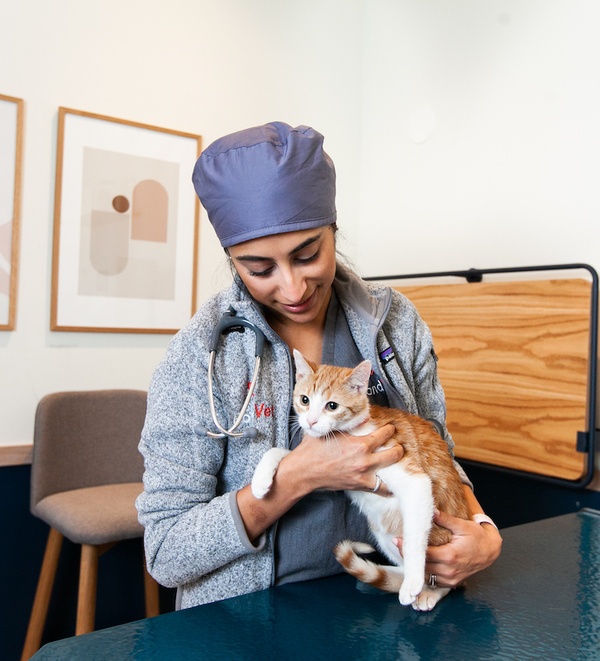
When Do Cats Go Into Heat?
If you have a female cat who isn’t spayed, she will come into heat. And, it may happen sooner — and more frequently — than you expect.
Read on to learn the signs indicating your cat is in heat, when to expect their first heat, and what heat cycles mean for your cat.
What Is a Heat?
A heat is part of your kitty’s estrus, or reproductive, cycle. It’s the time when she is fertile and looking for a mate.
However, in cats, that doesn’t necessarily mean ovulation occurs. Cats are induced ovulators, meaning, ovulation happens during the heat only if a female cat has mated — the act of breeding stimulates the release of eggs.
SEE ALSO: Cat Reproduction
How Will I Know If My Cat’s In Heat?
A female cat in heat is usually not difficult to spot — or, to hear!
Signs of estrus include:
- Vocalization. Your kitty will meow or yowl very loudly, sometimes referred to as “caterwauling.”
- Affectionate or clingy behavior (although some cats will be standoffish).
- Rolling around on the floor.
- Elevating their hindquarters in the air, especially when petted.
- Increased urination and urine odor (her urine will contain pheromones during this time), and possibly urine marking outside the litter box.
- Attempts to escape their home.
- Vaginal discharge or bleeding can also occur, but it’s unusual to see this.
Many of these behaviors, including the yowling, meowing, urinating, and attempts to escape the home, are your kitty’s efforts to find or attract a mate.
When Does a Kitten Get Their First Heat?
Most cats reach sexual maturity and have their first heat at around six months of age — although some can be a little later, and as young as four months is possible.
And, they can become pregnant with a litter of kittens as early as their first heat cycle.
How Long Does a Cat’s Heat Last?
An average cat's heat cycle can last anywhere from a few days to two weeks.
How Often Do Cats Go Into Heat?
Once estrous cycles begin, cats may go into heat as often as every 2-3 weeks.
Cats are seasonally polyestrus (also spelled polyestrous), meaning they can have multiple cycles during their breeding season.
Breeding season would normally be during warmer weather and longer daylight hours. But, since most cats in North America are indoor cats and live in comfortable conditions year round, cats can come into heat all year long (although some will be more frequent than others).
Also, cats don’t go through menopause, so heats continue in senior cats.
Does a Heat Mean My Cat Will Get Pregnant?
If your cat mates during her heat, yes, pregnancy is a possibility, even during their first heat.
To prevent pregnancy, separate your female kitty from any male cats in the household (including blood relatives).
Also, be sure doors and windows are secure. This will prevent your kitty from escaping to look for a mate, which will avoid not only pregnancy, but also the risks of getting lost or injured while outside.
Does a Heat Cause Discomfort?
It’s hard for us to know everything that goes on in a cat’s mind and body, especially since kitties hide their pain well. However, it’s reasonable to imagine there may be some discomfort.
Additionally, there are mental and emotional aspects to consider. A cat in heat has a strong physiological desire to mate, so they may experience frustration each heat cycle where a mating does not occur.
Can Being in Heat Cause Health Problems?
A common and serious health risk is called a “pyometra,” which is an infection that causes the uterus to fill with pus and bacteria, and can lead to a ruptured uterus, shock, and death.
Pyometras generally occur after several heat cycles with no mating (due to repeated thickening of the uterine lining), and they require an emergency spay surgery.
Signs to watch for include:
- Fever
- Vomiting
- Inappetence
- Lethargy
- Pus or other drainage from the vulva
If you notice any of these symptoms (even just one or two of them) within a few weeks after a heat, your kitty needs an immediate veterinary visit.
Not all unspayed cats will develop a pyometra, but it is a risk that is easily avoided by spaying your cat.
LEARN MORE ABOUT SPAYING AT BOND VET
Is There a Way to Prevent Heats?
There are injectable medications that can stop a heat cycle. However, because of the high risk of serious side effects (including pyometra), most veterinarians don’t recommend them unless the benefit clearly outweighs the risks.
Plus, these medications don’t last forever. Cats will come into heat again, and thus need additional injections, further increasing the risk of side effects, and making this method fairly inefficient for controlling heats.
The best, safest way to prevent heats is with a spay.
How Can I Help My Cat During Her Heat?
If your cat is showing signs of heat, follow her cues.
Some kitties are very affectionate and clingy and want extra attention. If that’s the case, try to give her extra cuddles or playtime. Other cats may be grumpy or want to be left alone. If that’s the case, give her some space.
Either way, extend patience and compassion to your furry BFF. Remember, her behavior is due to strong hormonal influences that she can’t control.
And, call your vet to learn about your options for spaying your cat.
A spay surgery will provide long-term heat and pregnancy prevention, and help your kitty avoid some of the behaviors and health risks that come from hormonal influences.